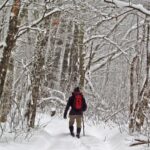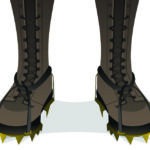Our Favorites for a Winter Adventure
Ready to set out on a winter hike, but not sure where to head? Here are some of our cold-weather favorites — and why they’re good choices.

weathercarrot
Rich Mountain Fire Tower
Hot Springs, North Carolina
The trailhead for this five-mile, out-and-back hike is easily accessible in all weather due to its location right next to a well-trafficked highway. You’ll get great views from the recently renovated fire tower, and there are no creek crossings on the way, so no need to worry about potentially swollen streams or getting your feet wet.
Upper Goose Pond
Lee, Massachusetts
This five-mile out-and-back takes you to beautiful Upper Goose Pond. The cabin at the north end of the pond is closed for the winter, but still offers a nice porch where you can enjoy lunch. The terrain here is gentle and relatively flat, making it less likely that slippery ice or steep snow climbs will impede your progress; and it keeps hikers protected from the wind with its lack of exposure and tree-lined path.
Hay Rock
Roanoke, Virginia
This eight-mile hike offers great views, plus a fun scramble up Hay Rock at the end if it isn’t icy. The trailhead is easily accessible from just off I-81, and the consistent climb to the ridge will warm you up. What makes this hike perfect for winter is its out-and-back nature and rewarding views along your way, so it still feels like a great hike if you need to turn around before reaching Hay Rock due to cold or fading light.
Gearing up for a Winter Hike

Head, face and neck protection
Keeping your head warm is essential. The sun can create an intense glare off the snow, so sunglasses are a good idea, too. And while many people forget about insulating their necks, a lot of heat can be lost there; wear a scarf or Buff for an extra layer.

Layers
A base layer and a combination of mid-layers and an outer shell is essential. Layers should be non-cotton and breathable; synthetic fabrics and merino wool work best for base layers, while water- and wind-proof layers for the torso and legs are key for combating the cold.

Gloves or mittens
Mittens are generally warmer than gloves. Make sure they’re waterproof if you’ll be handling snow.

Socks and shoes
Think quality over quantity. Wool socks will keep toes warm, and waterproof hiking boots are best if you’ll be hiking in snow.

Traction
Snowshoes are necessary for snow deeper than a couple of inches, and when you’re hiking on ice, MICROspikes® are key.
Meet the Author

The A.T. wove its way into Amanda Wheelock’s life when she moved from Georgia to New Hampshire to attend Dartmouth College. There, she worked on a Trail crew, taught backpacking, and hiked from Hanover to Moosilauke because it was “tradition.” She quickly discovered that her love of long-distance trails was more than just a college fling.
Amanda is now a Deputy District Ranger at the U.S. Forest Service for the Dillon Ranger District. Earlier in her career, she stayed connected to her first love by volunteering on the Appalachian Trail Conservancy’s Next Generation Advisory Council. “Writing about winter hiking toward the end of a year jam-packed with change gave me a welcome opportunity to look back at a wonderful weekend spent on the A.T.”
